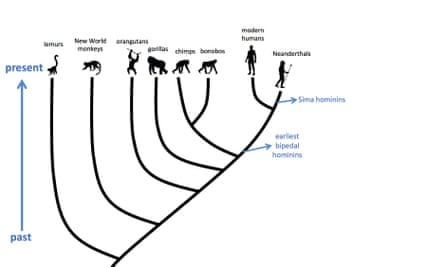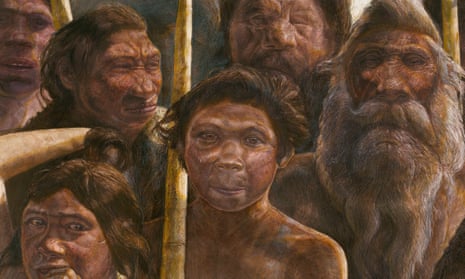Anthropologists and geneticists had a problem. And the farther back in time they looked, the bigger the problem became.
For the past several years, there have been two main genetic methods to date evolutionary divergences - when our ancestors split from Neanderthals, chimpanzees, and other relatives. The problem was, the results of these methods differed by nearly two-fold.
By one estimate, modern humans split from Neanderthals roughly 300,000 years ago. By the other, the split was closer to 600,000 years ago. Likewise, modern humans and chimps may have diverged around 6.5 or 13 million years ago.
Puzzled by this wild disagreement, researchers with diverse expertise have been studying it from different angles. Their combined discoveries, recently reviewed here and here, have shed light on how genetic differences accumulate over time and have advanced methods of genetic dating.

And if you’re in suspense, yes, they’ve also pinned down important events in our evolutionary timeline. Everyone alive today seems to share ancestors with each other just over 200,000 years ago and with Neanderthals between 765,000-550,000 years ago.
Dating with the molecular clock
Go back in time and you’ll find a population of Homo sapiens who were the ancestors of everyone living today. Go back farther and our lineage meets up with Neanderthals, then chimps, and eventually all primates, mammals, and life.
In order to date these evolutionary splits, geneticists have relied on the molecular clock - the idea that genetic mutations accumulate at a steady rate over time. Specifically this concerns mutations that become neutral substitutions, or lasting changes to letters of the genetic code that do not affect an organism’s chances of surviving and reproducing.
If such mutations arise clocklike, then calculating the time since two organisms shared common ancestors should be as easy as dividing the number of genetic differences between them by the mutation rate - the same way that dividing distance by speed gives you travel time.
But you need to know the rate.
For decades, anthropologists used fossil calibration to generate the so-called phylogenetic rate (a phylogeny is a tree showing evolutionary relationships). They took the geologic age of fossils from evolutionary branch points and calculated how fast mutations must have arisen along the resulting lineages.
For example, the earliest fossils on the human branch after our split with chimps are identified by the fact that they seem to have walked on two legs; bipedalism is the first obvious difference that distinguishes our evolutionary lineage of hominins from that of chimps. These fossils are 7-6 million years old, and therefore the chimp-human split should be around that age. Dividing the number of genetic differences between living chimps and humans by 6.5 million years provides a mutation rate.
Determined this way, the mutation rate is 0.000000001 (or 1x10-9) mutations per DNA base pair per year. Applied to genomes with 6 billion base pairs, that means, over millions of years of chimp and human evolution, there have been on average six changes to letters of the genetic code per year.
This rate can be used to date evolutionary events that are not evident from fossils, such as the spread of modern humans out of Africa.
But genetic dating got messy in 2010, when improvements to DNA sequencing allowed researchers to determine the number of genetic differences between parents and their children. Known as pedigree analysis, this provides a more direct measurement of the current mutation rate within one generation, rather than an average over millions of years.
Pedigree analysis counts 60-some mutations every generation; that converts to a rate approximately half the phylogenetic estimate—meaning evolutionary events would be twice as old.
The erratic molecular clock
Resolving this disagreement propelled researchers to reassess and revise their starting assumptions: How accurately were they counting the small number of differences between genomes of parents and children? Were fossils assigned to the correct branches of the evolutionary tree? And above all, how constant is the molecular clock?
It turns out that among primates, the molecular clock varies significantly by species, sex, and mutation type. A recent study found that New World monkeys (i.e. monkeys of the Americas like marmosets and squirrel monkeys) have substitution rates about 64% higher than apes (including humans). Within apes, rates are about 7% higher in gorillas and 2% higher in chimpanzees, compared to humans.

But even among humans, mutation rates differ, particularly between the sexes with age. As fathers get older, they gain about one additional mutation per year in the DNA they can pass on to children. Mothers, on the other hand, accumulate considerably fewer mutations with each passing year.
These species and sex differences make sense when you consider how mutations form. Most heritable mutations occur from mistakes when DNA copies itself in the germline, or cells leading to eggs and sperm. The number of times germline DNA has to copy itself depends on developmental and reproductive variables including age at puberty, age at reproduction, and the process of sperm production.
These traits vary across primates today, and certainly varied over primate evolution. For instance, average generation times are six years for New World monkeys, 19 years for gorillas, 25 years for chimps, and 29 years for humans.
And those extra mutations as fathers get older? Sperm are produced continuously after puberty, so sperm made later in life are the result of more rounds of DNA replication and opportunities for replication errors. In contrast, a mother’s stock of eggs is formed by birth. The small increase with maternal age could be due to mutations from DNA damage, rather than replication errors.
Ways forward for dating backwards
It’s now clear that one mutation rate cannot determine the dates for all divergences relevant to human evolution. However, researchers can secure the timeline for important evolutionary events by combining new methods of genetic dating with fossils and geologic ages.
Innovative computational methods have incorporated reproductive variables into calculations. By taking into account ages of reproduction in both sexes, age of male puberty, and sperm production rates, researchers have estimated split times that accord with the fossil record.
Another new approach has analysed mutations that are mainly independent of DNA replication. It seems that certain classes of mutations, related to DNA damage, do behave more clocklike.
And some researchers have focused on ancient DNA. Comparing human fossils from the past 50,000 years to humans today, suggests a mutation rate that agrees with pedigree analysis.
At least one evolutionary split was pinned down in 2016, after ancient DNA was extracted from 430,000 year-old hominin fossils from Sima de los Huesos, Spain. The Sima hominins looked like early members of the Neanderthal lineage based on morphological similarities. This hypothesis fit the timing of the split between Neanderthals and modern humans based on pedigree analysis (765,000-550,000 years ago), but did not work with the phylogenetic estimate (383,000-275,000 years ago).
Where do the Sima hominins belong on our family tree? Were they ancestors of both Neanderthals and modern humans, just Neanderthals, or neither?
DNA answered this definitively. The Sima hominins belong to the Neanderthal branch after it split with modern humans. Moreover, the result provides a firm time point in our family tree, suggesting that the pedigree rate works for this period of human evolution.
Neanderthals and modern humans likely diverged between 765,000-550,000 years ago. Other evolutionary splits may soon be clarified as well, thanks to advances brought about by the mutation rate debates. Someday soon, when you see a chimp, you may be able to salute your great, great… great grandparent, with the correct number of “greats.”
Thanks to Priya Moorjani and David Pilbeam for their input on this piece.

Comments (…)
Sign in or create your Guardian account to join the discussion